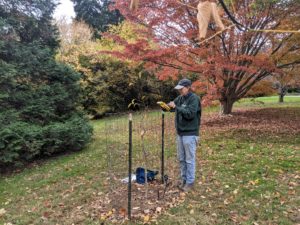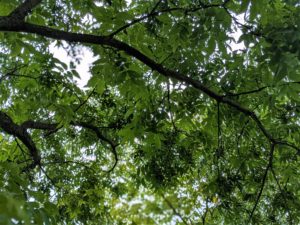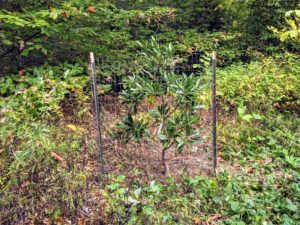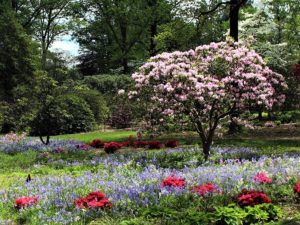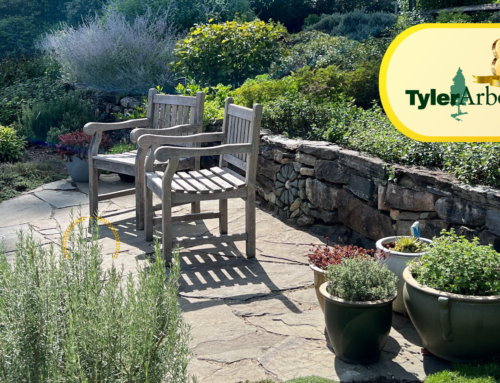During the 1840s the Painter Brothers, Jacob and Minshall, began to plant trees for a very specific purpose — they wanted to study plants. These plants were the beginning of the Tyler Plant Collection, and you can still find 20 specimens growing at the Arboretum today.
A Plant Collection is the grouping of plants in a genus or species that is planned and maintained by a public garden or arboretum with the purpose of public education, research, conservation, and higher learning. We have inherited a number of plant collections here at Tyler, including our Crabapple, Cherry, Lilac, Magnolia and Rhododendron Collections. These historic collections were planned by our first Executive Director, Dr. Wister. We also have the Pinetum, which was designed in partnership with Gertrude Wister to showcase different genera and species of conifers.
From 1840 to the 1960s, plant species were deliberately added for scientific study, as well as to display them to the general public. Our hope is that visitors to Tyler will explore our collections to learn more about these diverse plants, how they can be used in a garden setting, and which varieties grow well in our area. Of particular note, our Lilac Collection was planted to showcase the very best varieties to grow in our area, and now more than 70 years later, they still bloom each spring with an intoxicating variety of flowers in pinks, purples and whites. We also maintain our collections to preserve the genetics of unique plants. In our Wister Rhododendron Collection, you can find varieties of rhododendrons and azaleas that are found nowhere else in the trade. Visit our website for more information about Plant Collections at Tyler.
But plants, like people, have a life span – albeit a much longer one. For instance, white oaks can live to be 300 years old, and ginkgoes can live even longer, with some reaching 3,000 years old in their native range. Every day we care for our historic plants in the hopes that they will be with us for decades, or centuries, to come. But we also take steps to plant new trees and shrubs, so that when those older specimens reach the natural end of their lives, we will still be home to a diverse and important collection of plants. We take this process of collecting and planting trees and shrubs seriously, and we choose plants for a number of specific reasons.
For one, we plant trees at Tyler to expand our collections. Thanks to the 2021 Member’s Choice Project, we planted two new pecan trees (Carya illinoinensis ‘Pawnee’, and Carya illinoinensis ‘Kanza’) in our Crabapple Collection. Pecan trees are a beautiful native tree, the largest of our hickory species, with a wide, spreading crown. And, of course, they are responsible for pecans, which grace our Thanksgiving table each year in the form of pecan pie. This use of pecans is nothing new, as the word ‘pecan’ is believed to come from the Algonquin word Pakani. First Nations tribes throughout the pecans’ native range have relied on pecans for both food and trade. Adding these pecan trees to Tyler helps us to educate the public and honor this important native food species. For more information on the history and importance of nuts, you can visit our Artful Arboretum article “The Necessary Nut.” It also allows us to compare two different cultivars, or cultivated varieties, of pecan – ‘Pawnee’, which is known for producing a heavy crop of pecans earlier than other varieties, and ‘Kanza’, which has demonstrated great resistance to scab. These two trees will work together, as pecans benefit from cross pollination. It takes about 8 – 10 years for pecan trees to produce nuts, so come back to visit in the 2030s!
We also plant trees to replace ones that we have lost. This year, a serious wind storm brought down a beech tree in the Native Woodland Walk, effecting a change in light levels. In nature, when there is a break in canopy, species that can quickly take advantage of this will thrive. Mallory Smyth, gardener, replanted several shrubs and trees specifically addressing this new opportunity. Shrubs included red chokeberry ‘Brilliantissima’ (Aronia arbutifolia ‘Brilliantissima’), buttonbush ‘Sugar Shack’ (Cephalanthus occidentalis ‘SMCOSS’ SUGAR SHACK), and sweetbay magnolia ‘Green Shadow’ (Magnolia virginiana ‘Green Shadow’). All three of these species will thrive in the moist, shady conditions of the site.
Chokeberry ‘Brilliantissima’ is a well-known cultivar of chokeberry that grows slowly until it reaches a height of six to eight feet. It’s best known, however, for its stunning, multicolor autumn foliage and abundant fruit. Buttonbush ‘Sugar Shack’ is a very interesting variety of the native buttonbush that was grown by Proven Winners. Like the straight species, it retains its beautiful fall color and lovely white flowers – but in miniature form! While wild buttonbush can grow to be about ten feet tall, ‘Sugar Shack’ reaches only four feet in height. Finally, Magnolia ‘Green Shadow’ is a more reliably evergreen variety of sweetbay magnolia, which adds visual interest to the garden in winter, as well as beautiful fragrant summer flowers. The Native Woodland Walk is planned and planted to showcase the beauty and adaptability of native plants, and these new varieties will help visitors experience multiple seasons of interest and, we hope, take home ideas to use in their gardens. You can learn more about the design intent and history of this beautiful garden in our article “Exploring the Native Woodland Walk with Gardener Mallory Smyth.”
Additionally, we plant to support our partnerships with other public gardens in the area, and to preserve the genetics of interesting species or varieties. This year we added five sweet azalea, Rhododendron arborescens, to the collection. They were seedlings grown by Steve Wright, Director of Horticulture at Jenkins Arboretum. Six other rhododendrons of different types were donated by the American Rhododendron Society, including one known only as Rhododendron x AA35. This mysterious rhododendron is a cutting from Mike Steward of Dover Nursery in Sandy, Oregon. It was bred by Allan and Shirley Anderson, recipients of the 2012 Silver Medal Award given by the American Rhododendron Society for their work in hybridization. We don’t know the parentage of AA35, but when a cross section was taken of one of its buds, the flower petals were revealed to be red. The Andersons passed in 2019 and 2020, so this plant is a living legacy of their hard work. We’re honored to plant it in our collection and look forward to seeing it bloom in the spring. The Wister Rhododendron Collection is unique because it serves as a vast repository of rhododendron species genetics. Many of the plants growing there today are a result of the breeding work done by Charles Dexter, one of the notable rhododendron hybridizers of the 1900s. It is a priority of Tyler’s to work with other organizations in the area to continue to preserve these rare and unique plants and a time-honored tradition to seek out new and exciting varieties. For more information on the Wister Rhododendron Garden and the plants in the collection, check out our article “The Wister Rhododendron Garden”.
This is by no means a complete list of the plants we planted in 2021, nor of the reasons why we make particular plant selections. In total this year, over 100 trees and shrubs were planted to beautify the landscape, increase our collections, preserve unique or special species, and support local wildlife. Each year we discover a new exciting cultivar, a species we haven’t yet tried growing, or a new way to grow an old garden friend. We hope that by continuing to plant each year, we honor the legacy left by the Painter Brothers and Dr. Wister, and carry their quest for knowledge into the future. In 200 years Tyler may look very different. Different trees may shade the people who come out to visit, and different shrubs may bloom in the spring. But the spirit of appreciation for the plant world will remain the same. And, who knows? One of the trees planted in 2021 by staff and volunteers may be a towering historic tree — a new witness to history.


